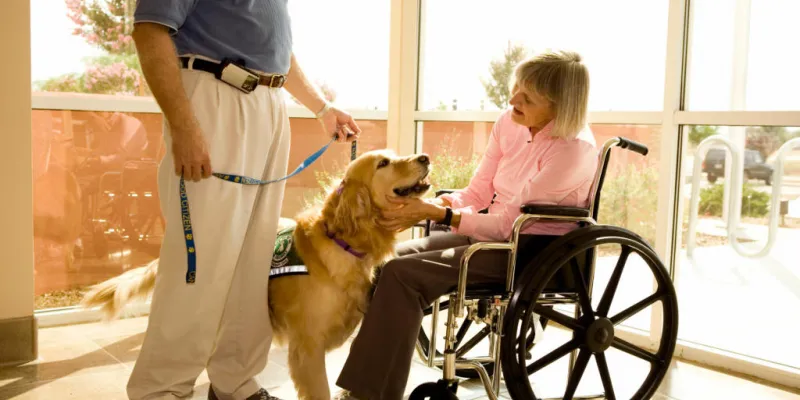Training tips
How to Train a Therapy Dog: Turning Your Furry Friend into a Comfort Companion

Therapy dogs are specially trained to bring comfort and relief to individuals in hospitals, schools, nursing homes, and other care facilities.
Dogs bring joy, companionship, and comfort to our lives, but some dogs go even further by providing emotional and therapeutic support to people in need. Therapy dogs are specially trained to bring comfort and relief to individuals in hospitals, schools, nursing homes, and other care facilities. If you’ve ever wondered how to train a therapy dog or what the process involves, this guide will help you understand the basics of therapy dog training and the steps to get started.
What Is Therapy Dog Training?
Therapy dog training focuses on preparing a dog to provide emotional support to people in various settings. Unlike service dogs, who perform specific tasks for individuals with disabilities, therapy dogs offer general comfort and affection. They visit hospitals, schools, and other facilities to help reduce stress, provide companionship, and support emotional well-being.
The Difference Between Therapy Dog Training and Service Dog Training
It’s important to note that therapy dog training is different from service dog training. Service dogs are trained to perform tasks for a person with a disability, such as guiding the visually impaired, alerting someone with a hearing impairment, or retrieving items for a person with mobility issues. Training a service dog typically involves teaching specific tasks tailored to the needs of the individual owner.
Therapy dog training, on the other hand, is centered on teaching a dog to remain calm, well-behaved, and comfortable in various environments. Therapy dogs do not have the same public access rights as service dogs but can provide significant comfort and emotional support in appropriate settings.
How to Train a Therapy Dog: Key Steps
If you’re interested in training your dog to become a therapy dog, here are some key steps to follow:
- Start with Basic Dog Training: Before diving into specialized therapy dog training, your dog should master basic commands like “sit,” “stay,” “come,” and “heel.” Basic dog training ensures your dog can follow instructions and behave well in various situations.
- Focus on Socialization: Therapy dogs need to be comfortable around different people, environments, and even other animals. Expose your dog to various social settings, allowing them to interact with people of all ages, including children, adults, and seniors.
- Enroll in Obedience Classes: Professional obedience classes can help refine your dog’s behavior. Look for classes that specifically focus on pet therapy dog training to prepare your dog for the unique challenges of being a therapy dog.
- Therapy Dog Certification: After basic and specialized training, you can pursue therapy dog certification. Organizations like Therapy Dogs International and the Alliance of Therapy Dogs offer programs that evaluate a dog’s behavior and temperament to determine if they’re ready for therapy work.
Training Therapy Dogs for Specific Roles
Therapy dog training can be customized based on the type of therapy work the dog will perform. Here are a few common settings where therapy dogs play a valuable role:
- Hospitals and Nursing Homes: Therapy dogs visit patients to provide comfort, reduce anxiety, and offer a calming presence.
- Schools: Therapy dogs can help reduce stress among students, especially during exam periods, or assist with reading programs where children read aloud to the dog to improve literacy skills.
- Disaster Response: In the aftermath of traumatic events, therapy dogs are deployed to offer emotional support to victims and first responders.
Tips for Successful Dog Therapy Training
- Use Positive Reinforcement: Rewarding good behavior with treats, praise, or playtime is an effective way to motivate your dog during training.
- Practice Patience: Every dog learns at their own pace, so be patient and consistent with your training approach.
- Work on Calmness: Therapy dogs need to remain calm in various situations, even if there are loud noises or unfamiliar people. Practice training in different environments to build your dog’s confidence.
The Benefits of Therapy Dog Training
Training a therapy dog not only provides benefits to the people the dog helps but also to the dog itself. Therapy dogs enjoy the mental stimulation and social interaction that come with their work. Additionally, pet owners experience a deep sense of fulfillment knowing their dog is making a positive impact on others' lives.
Why Choose Calidognia for Therapy Dog Training?
At Calidognia, we understand the unique requirements of training therapy dogs. Our experienced trainers offer customized programs for therapy dog training, ensuring your dog is prepared for any setting. Whether you're interested in dog therapy training or need guidance on training a service dog, we can help you every step of the way.
Let’s transform your dog into a comforting companion that makes a difference. Contact Calidognia today to learn more about our training programs.




